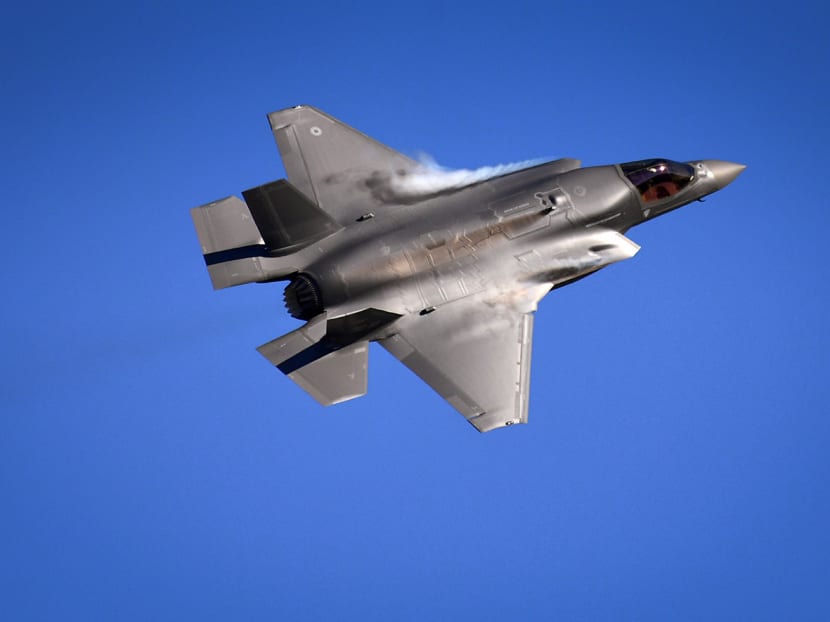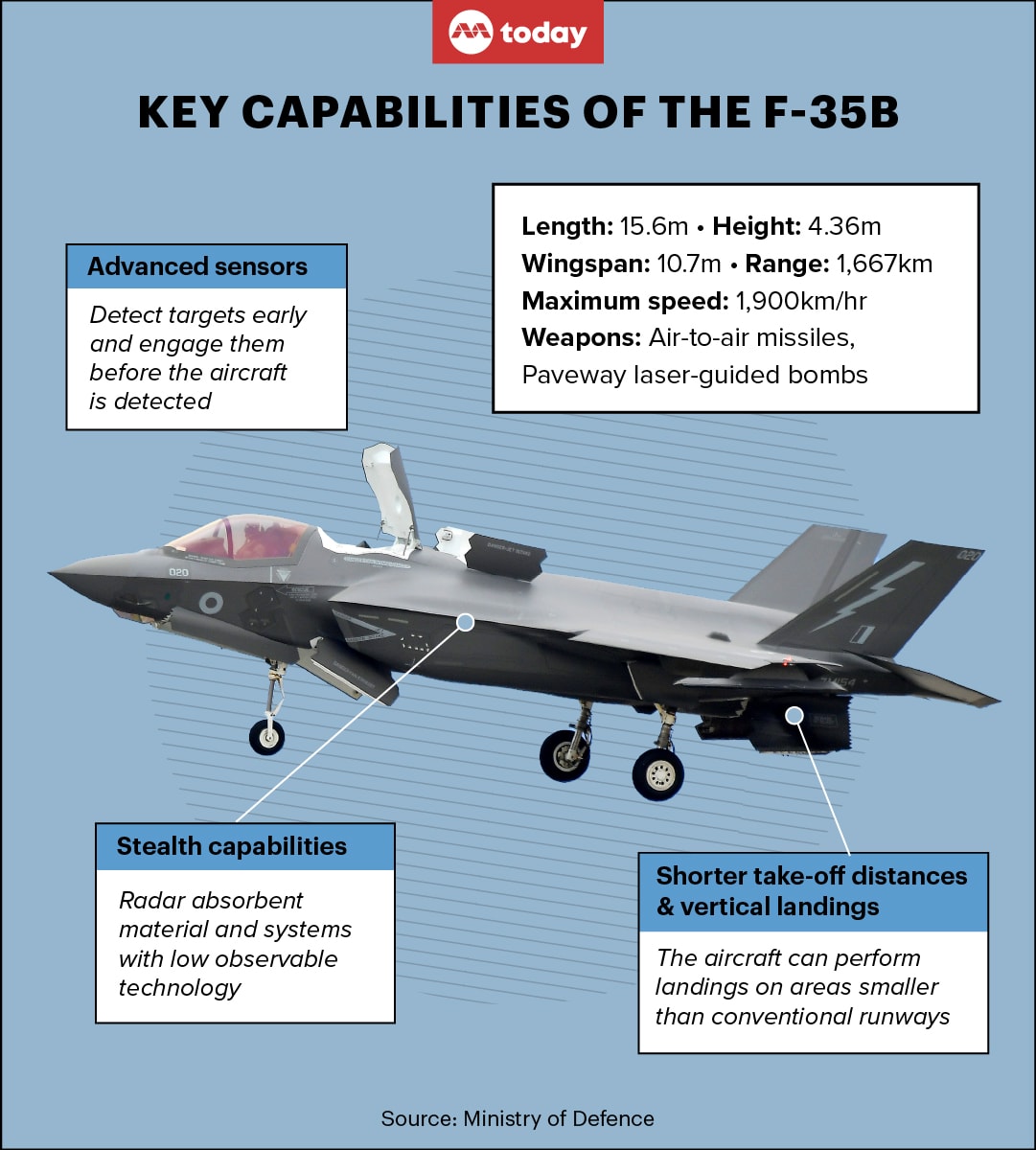Singapore to buy 8 more F-35B fighter aircraft; FY23's defence budget to rise by 5.6%: Ng Eng Hen
SINGAPORE — The Ministry of Defence (Mindef) will be exercising the option to acquire eight more F-35B fighter aircraft set to be delivered by 2029 on top of four of the aircraft that it ordered in 2020, Defence Minister Ng Eng Hen said in Parliament on Friday (Feb 24).

The F-35B aircraft (pictured) can travel at a maximum speed of about 1.6 times the speed of sound, or about 1,900km/h.
- Singapore's Ministry of Defence will acquire eight F-35B fighter aircraft by 2029 to replace the ageing F-16 fleet
- They are in addition to four F-35B aircraft that Singapore ordered in 2019, Defence Minister Ng Eng Hen said
- The key capabilities of the F-35Bs include stealth technology, shorter take-off distances and vertical landings, and advanced sensors
- Defence spending will also rise by 5.6 per cent due to inflationary pressures, Covid-19 disruptions, and the acceleration of digitalisation efforts
SINGAPORE — The Ministry of Defence (Mindef) will be exercising the option to acquire eight more F-35B fighter aircraft set to be delivered by 2029 on top of four of the aircraft that it ordered in 2020, Defence Minister Ng Eng Hen said in Parliament on Friday (Feb 24).
Dr Ng was speaking during the Committee of Supply debate on his ministry’s budget, where he also noted that defence spending in the current financial year will be a projected S$18 billion, or a 5.6 per cent increase from financial year 2022.
The increase was due to several factors: Inflationary pressures, catching up on projects deferred by Covid-19 disruptions, and the acceleration of Mindef's digitalisation efforts.
“We need to remind ourselves constantly that investing steadily in defence is the more prudent and cost-effective strategy, especially during good times and peacetime.Defence Minister Ng Eng Hen”
He added that Mindef needs to take a long-term view on defence spending and invest steadily to avoid disruptions arising from fluctuations in government expenditure.
“We need to remind ourselves constantly that investing steadily in defence is the more prudent and cost-effective strategy, especially during good times and peacetime,” Dr Ng said.
"It’s not just the dollars spent, but the know-how, human capital, culture and most importantly, the psychology and mental build-up of commanders and soldiers."
WHY WERE THE EIGHT AIRCRAFT PURCHASED?
In 2019, Mindef announced that it would buy four F-35B fighter aircraft, with the option to acquire eight more later.
Dr Ng said that after an extensive and robust evaluation, the ministry will exercise that option and but the eight additional aircraft, which would augment its capabilities.
“This acquisition will support the progressive drawdown of our ageing F-16s, which we will retire from the mid-2030s,” he added.
After agreeing to buy the initial four F-35B aircraft, it gave personnel from the Republic of Singapore Air Force (RSAF) and the Defence Science and Technology Agency (DSTA) users-only access to evaluate the planes, Mindef said in a separate statement released on Friday.
For instance, the technical and operational understanding of how the aircraft would fit into Singapore’s war fighting fleet, as well as training and professional engagements, were conducted.
“These efforts allowed the RSAF and DSTA to fully understand the F-35B’s capabilities and its compatibility with the Singapore Armed Forces' warfighting systems, before making an informed decision to exercise and acquire the eight additional F-35Bs,” Mindef said.
The first four of aircraft that were said to be purchased in 2019 are on track to be delivered to Singapore by 2026, while the remaining eight will be delivered by 2029.

WHAT ARE THE KEY CAPABILITIES OF THE F-35B?
The key capabilities of the F-35B include:
- Stealth capabilities such as radar absorbent material and systems with low observable technology, meaning the F-35Bs are able to evade enemy detection and operate in “contested environments”, Mindef said
- Shorter take-off distances and vertical landings, meaning that the aircraft can perform landings on areas smaller than conventional runways. This is important because it offers “operational flexibility given Singapore’s land scarcity”, Mindef added
- Advanced sensors to “collect analyse and fuse information gathered”, helping the Singapore Armed Forces to detect targets early and engage them before the aircraft is detected
The aircraft is 15.6m long and has a height of 4.36m — about the length and height of a double-decker bus — and a wingspan of 10.7m.
It has a range of 1,667km and can travel at a maximum speed of about 1.6 times the speed of sound, or about 1,900km/h.
It has a suite of weapons such as the heatseeking Sidewinder and the radar-guided Amraam air-to-air missiles.
THE BIG PICTURE
Dr Ng laid out the context that Singapore finds itself in — one where Russia's invasion of Ukraine and rising US-China tensions are "seminal forces" that will impede, if not unravel, globalisation.
He said that these changes are bound to affect Singapore, given that external trade makes up three-and-a-half times its gross domestic product (GDP).
While European Union countries are pledging to spend more on defence in the face of Russia's invasion of Ukraine, closer to home, Asian countries are also increasing their military spending.
For instance, China is estimated to spend in excess of US$270 billion (S$364 billion) on its defence and announced a 7.1 per cent increase last year, while South Korea wants to bump up defence spending by an annual average of 6.8 per cent over the next five years.
"Taken together, Asia’s military spending on the whole has already surpassed Europe’s in 2009 (and) the gap has since widened even further," Dr Ng said.
"What will all this lead to? I doubt anyone can be really sure, but without a robust framework to maintain peace, this up-sizing of Asian militaries can spell trouble ahead."
Dr Ng said that Mindef and SAF have also been watching the war in Ukraine "very closely", because it is the only war in which modern, state-on-state warfare has been fought in recent times.
"There are indeed military lessons to be learnt, but more important than military lessons, examples of how the people — ordinary citizens — make the crucial difference, not only in civilian affairs but military, too."
For instance, ordinary Ukrainian citizens have repurposed items such as shuttlecocks to attach onto grenades, so that they may be lifted up by commercial drones and dropped in enemy targets with more accuracy.
Ukraine’s armed forces also relied on its civilians to crowd-source military intelligence though mobile applications.
"If the war has taught us anything, it must be that weaponry and fighting platforms are important, but ultimately, it is the fighting spirit of the people that will decide if they end up subjugated or sovereign," Dr Ng said.
"We Singaporeans must build and have that same spirit and resolve. Our lives and our country will depend on it."
INCREASE IN DEFENCE BUDGET
Dr Ng noted that some people had pushed for a cut in defence spending.
"Outside this Parliament, some political personalities did push for reduction — saying that our defence spending is 'excessive' and that external threats for us 'don’t exist'," he said.
"To them, I say — never sacrifice a strong defence for Singapore at the altar of political expediency... It may win some votes, but risks losing Singapore in that self-interest."
He added that defence is a "long-term business". For instance, the Singapore Armed Forces' major systems and platforms take 10 to 15 years to conceptualise, build and integrate into the country's fighting force.
Dr Ng also said that there have been fluctuations in defence spending in the last few years due to the Covid-19 pandemic. Moving forward, the spending will smoothen out and keep pace with inflation.
Mindef will strive to keep the growth of Singapore’s defence budget in line with inflation, and it has achieved this target for the past decade at about 4.3 per cent growth each year, he added.
Overall, Mindef’s spending has stabilised at between 3 per cent and 4 per cent of the country's GDP.
"Barring increasing tensions or persistent high inflation where military spending may have to go up, Mindef expects this to be the steady state spending," Dr Ng said.
UPDATES ON DIGITAL AND INTELLIGENCE SERVICE, NSMEN EXIT PERMIT REQUIREMENTS
Dr Ng also gave updates on the SAF’s fourth service, the Digital and Intelligence Service (DIS) that was established last year to address emerging threats in the digital domain.
He said that more than 350 NSFs have signed on since the launch of the Cyber Work-Learn Scheme in 2018 for full-time national servicemen (NSFs) to engage in real-world cybersecurity operations, and a new Digital Work-Learn Scheme last year for NSFs to contribute in areas such as software development and artificial intelligence.
The DIS also saw a 40 per cent increase in job applications in the past year.
“A significant number of applications for non-uniformed roles have been received from mid-career professionals,” he said.
Dr Ng also said that cyber agencies here are concerned about external and orchestrated attacks by state and non-state actors, such as terrorist groups. “The DIS has picked up on some entities and is monitoring them for their activities.”
The DIS will also set up the Digital Ops-Tech Centre run by software engineers and data scientists to provide “in-house software development”, Dr Ng added without giving more details on this centre, which will be operational in 2024.
An update on Exit Permit requirements for operationally ready national servicemen (NSmen) was also given by Senior Minister of State for Defence Heng Chee How in Parliament on Monday.
From April onwards, NSmen will only need to apply for an Exit Permit when they leave Singapore for 12 months or more, up from the current six months or more, he said.
"This change reflects the growing mobility of Singaporeans, with many of our NSmen staying or working overseas for longer durations," said Mr Heng, adding that such a change would not affect SAF's operational readiness.








